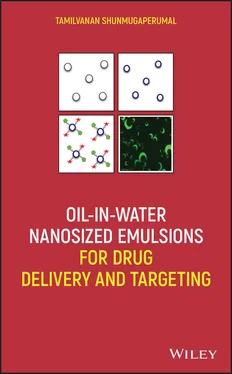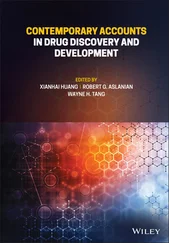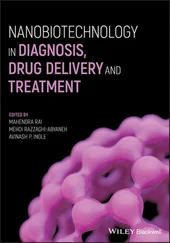67 Naskar, M.K., Patra, A., and Chatterjee, M. (2006), Understanding the role of surfactants on the preparation of ZnS nanocrystals, J. Colloid Interface Sci., 297 (1), 271–275. doi:10.1016/j.jcis.2005.10.057
68 Negi, P., Singh, B., Sharma, G. et al. (2015), Biocompatible lidocaine and prilocaine loaded‐nanosized emulsion system for enhanced percutaneous absorption: QbD‐based optimisation, dermatokinetics and in vivo evaluation, J. Microencapsul., 32 (5), 419–431. doi:10.3109/02652048.2015.104651
69 Nobs, L., Buchegger, F., Gurny, R. et al. (2004), Current methods for attaching targeting ligands to liposomes and nanoparticles, J. Pharm. Sci., 93 (8), 1980–1992. doi:10.1002/jps.20098
70 Ogawa, S., Decker, E.A., and McClements, D.J. (2003), Production and characterization of o/w emulsions containing cationic droplets stabilized by lecithin‐chitosan membranes, J. Agric. Food Chem., 51 (9), 2606–2812. doi:10.1021/jf020590f
71 Orloff, J.J. (2011), The promise and threat of quality risk management, Pharm. Technol., 35 (2), 38–40.
72 Pickering, S.U. (1907), Emulsions, J. Chem. Soc., 91, 2001–2021. doi:10.1039/CT9079102001
73 Pongcharoenkiat, N., Narsimhan, G., Lyons, R.T. et al. (2002), The effect of surface charge and partition coefficient on the chemical stability of solutes in o/w emulsions, J. Pharm. Sci., 91 (2), 559–570. doi:10.1002/jps.10064
74 Puri, D., Khatik, G.L., and Tamilvanan, S. (2019), Studies on olive‐and silicone‐oils‐based Janus macroemulsions containing ginger to manage primary dysmenorrheal pain, Mater. Sci. Eng. C Mater. Biol. Appl., 100, 276–285. doi:10.1016/j.msec.2019.01.137
75 Q8(R2) (2009), ICH harmonized tripartite guideline for pharmaceutical development, current step 4 version, (Accessed on August 1, 2019).
76 Simberg, D., Weisman, S., Talmon, Y. et al. (2003), The role of organ vascularization and lipoplex‐serum initial contact in intravenous murine lipofection, J. Biol. Chem., 278, 39858–39865. doi:10.1074/jbc.M302232200
77 Simovic, S. and Prestidge, C.A. (2003), Adsorption of hydrophobic silica nanoparticles at the PDMS droplet‐water interface, Langmuir, 19, 8364–8370. doi:10.1021/la0347197
78 Simovic, S. and Prestidge, C.A. (2007), Nanoparticle layers controlling drug release from emulsions, Eur. J. Pharm. Biopharm., 67 (1), 39–47. doi:10.1016/j.ejpb.2007.01.011
79 Simovic, S. and Prestidge, C.A. (2008), Colloidosomes from controlled interaction of submicrometer triglyseride droplets and hydrophilic silica nanoparticles, Langmuir, 24, 7132–7137. doi:10.1021/la800862v
80 Song, Y.K., Liu, D., and Maruyama, K.Z. (1996), Antibody mediated lung targeting of long‐circulating emulsions, PDA J. Pharm. Sci. Technol., 50 (6), 372–377.
81 Sonne, M.R. (2015), Tocopherol compositions for delivery of biologically active agents, in: USPTO Patent full‐text and image database no. 6,193,985, Dumex, Copenhagen, pp. 1–21.
82 Solans, C., Izquierdo, P., Nolla, J. et al. (2005), Nano‐emulsions, Curr. Opin. Colloid Interface Sci., 10 (3–4), 102–110. doi:10.1016/j.cocis.2005.06.004
83 Swietlikowska, D.W. and Sznitowska, M. (2006), Partitioning of parabens between phases of submicron emulsions stabilized with egg lecithin, Int. J. Pharm., 312 (1–2), 174–178. doi:10.1016/j.ijpharm.2006.01.005
84 Sznitowska, M., Janicki, S., Dabrowska, E.A. et al. (2002), Physicochemical screening of antimicrobial agents as potential preservatives for submicron emulsions, Eur. J. Pharm. Sci., 15 (5), 489–495. doi:10.1016/s0928‐0987(02)00034‐9
85 Tadros, T. (2006), Principles of emulsion stabilization with special reference to polymeric surfactants, J. Cosmet. Sci., 57, 153–169.
86 Tadros, T., Vandamme, A., Levecke, B. et al. (2004), Stabilization of emulsions using polymeric surfactants based on inulin, Adv. Colloid Interf. Sci., 108–109, 207–226. doi:10.1016/j.cis.2003.10.024
87 Tambe, D.E. and Sharma, M.M. (1993), Factors controlling the stability of colloid‐stabilized emulsions: I. an experimental investigation, J. Colloid Interface Sci., 157, 244–253. doi:10.1006/jcis.1993.1182
88 Tamilvanan, S. (2004), Oil‐in‐water lipid emulsions: implications for parenteral and ocular delivering systems, Prog. Lipid Res., 43 (6), 489–533. doi:10.1016/j.plipres.2004.09.001
89 Tamilvanan, S. (2008), Oil‐in‐water nanosized emulsions: medical applications, in: Gad, S.C., Ed., Pharmaceutical Manufacturing Handbook, Chapter 7.4, John Wiley & Sons Publishers, Hoboken, NJ, pp. 1329–1368. doi:10.1002/9780470259818.ch34
90 Tamilvanan, S. (2009), Formulation of multifunctional oil‐in‐water nanosized emulsions for active and passive targeting of drugs to otherwise inaccessible internal organs of the human body, Int. J. Pharm., 381 (1), 62–76. doi:10.1016/j.ijpharm.2009.08.001
91 Tamilvanan, S. and Benita, S. (2004), The potential of lipid emulsion for ocular delivery of lipophilic drugs, Eur. J. Pharm. Biopharm., 58 (2), 357–368. doi:10.1016/j.ejpb.2004.03.033
92 Tamilvanan, S., Khoury, K., Gilhar, D. et al. (2001), Ocular delivery of cyclosporin A. I. Design and characterization of cyclosporin A‐loaded positively‐charged submicron emulsion, STP Pharma Sci., 11, 421–426.
93 Tamilvanan, S., Kumar, B., Senthilkumar, S.R. et al. (2010), Stability assessment of injectable castor oil‐based nanosized emulsion containing cationic droplets stabilized by poloxamer‐chitosan emulsifier films, AAPS PharmSciTech., 11 (2), 904–909. doi:10.1208/s12249‐010‐9455‐3
94 Tamilvanan, S., Schmidt, S., Müller, R.H. et al. (2005), In vitro adsorption of plasma proteins onto the surface (charges) modified‐submicron emulsions for intravenous administration, Eur. J. Pharm. Biopharm., 59 (1), 1–7. doi:10.1016/j.ejpb.2004.07.001
95 Tang, S.Y., Manickam, S., Wei, T.K. et al. (2012), Formulation development and optimization of a novel cremophor EL‐based nanoemulsion using ultrasound cavitation, Ultrason. Sonochem., 19 (2), 330–345. doi:10.1016/j.ultsonch.2011.07.001
96 Teixeira, H., Dubernet, C., Puisieux, F. et al. (1999), Submicron cationic emulsions as a new delivery system for oligonucleotides, Pharm. Res., 16, 30–36. doi:10.1023/A:1018806425667
97 Trotta, M., Pattarino, F., and Ignoni, T. (2002), Stability of drug‐carrier emulsions containing phosphatidylcholine mixtures, Eur. J. Pharm. Biopharm., 53 (2), 203–208. doi:10.1016/s0939‐6411(01)00230‐2
98 Velev, O.D., Furusawa, K., and Nagayama, K. (1996), Assembly of latex particles by using emulsion droplets as templates. 1. Microstructured hollow spheres, Langmuir, 12, 2374–2384. doi:10.1021/la9506786
99 Weiss, C.K., Lorenz, M.R., Landfester, K. et al. (2007), Cellular uptake behavior of unfunctionalized and functionalized PBCA particles prepared in a miniemulsion, Macromol. Biosci., 7, 883–896. doi:10.1002/mabi.200700046
100 Woitiski, C.M. Veiga, F. Ribiero, A. et al. (2009), Design for optimization of nanoparticles integrating biomaterials for orally dose insulin, Eur. J. Pharm. Biopharm., 73 (1), 25–33. doi:10.1016/j.ejpb.2009.06.002
101 Yaseen, M., Lu, J.R., Webster, J.R.P. et al. (2006), The structure of zwitterionic phosphocholine surfactant monolayers, Langmuir, 22, 5825–5832. doi:10.1021/la053316z
102 Yi, S.W., Yune, Y., Kim, T.W. et al. (2000), A cationic lipid emulsion/DNA complex as a physically stable and serum‐resistant gene delivery system, Pharm. Res., 17, 314–320. doi:10.1023/A:1007553106681
103 Yilmaz, H. and Borchert, H.H. (2005), Design of a phytosphingosine‐containing, positively charged nanoemulsion as a colloidal carrier system for dermal application of ceramides, Eur. J. Pharm. Biopharm., 60, 91–98. doi:10.1016/j.ejpb.2004.11.009
104 Yu, L.X. (2008), Pharmaceutical quality by design: product and process development, understanding, and control, Pharm. Res., 25 (4), 781–791. doi:10.1007/s11095‐007‐9511‐1
Читать дальше












